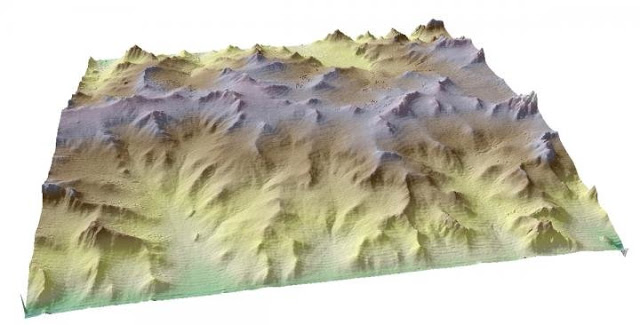
University of Oregon geologists have seen ridges and valleys form in real time and — even though the work was a fast-forwarded operation done in a laboratory setting — they now have an idea of how climate change may impact landscapes.
On a basic-science front, the findings, which appear in the July 3 issue of the journal Science, provide a long-sought answer to why some landscape features appear so orderly, with distinct and evenly spaced valleys and ridges.
Picture the Painted Hills near John Day, Oregon, the Colorado Plateau, the badlands of Montana and South Dakota, and even portions of the Coastal Range between Eugene and Florence, Oregon. These watersheds are masterpieces that nature has formed over geological timescales, said the UO’s Joshua J. Roering.
The regularity of hill and valley landforms, he said, is reached after a long tug-of-war between erosion driven by runoff, which influences how rivers cut their paths in valley floors, and soil movement on hillsides caused by disturbances from such things as burrowing gophers, tree roots, digging ants and frost.
The National Science Foundation-funded project (EAR 1252177) is part of a growing effort in geomorphology — the study of the origin and evolution of many landscape features — to understand how soil processes at work on hillsides compete with water runoff in the formation of valley floors.
Put simply, runoff processes carve valleys while soil movement on hill slopes tends to fill them. The relative vigor of these competing forces determines the spacing of hills and valleys and the degree of drainage dissection. “Hill-slope processes help determine valley density and the way valleys and ridges form,” Roering said. “These networks are climate dependent.”
Over the course of five 20-hour experiments conducted in small sandboxes, UO doctoral student Kristin E. Sweeney, the study’s lead author, extruded crystalline silica to represent uplift due to tectonic forces. To induce erosion, she used mist from 42 nozzles to create precipitation-driven runoff and 625 blunt needles that fired periodic bursts of large water drops to mimic natural disturbances that occur on hill slopes. Each experiment showed how the processes, acting together, converted flat plains into ridges and valleys.
“In our experiments we were able to dictate the processes involved and observe the landscapes that arise,” Sweeney said. “We were able to directly control the various processes. Previous research has only attempted to replicate channel processes — what the rivers do. We essentially started from scratch, working to see the movement of sediment slopes in a realistic way.
“Ridges and valleys are part of a fundamental landscape pattern that people easily recognize,” she said. “From an airplane, you look down and you see watersheds, you see valleys, and they tend to have very regular spacing. Explaining this pattern is a fundamental question in geomorphology.”
The study’s three-member team also included Christopher Ellis, senior research associate at the University of Minnesota’s St. Anthony Falls Laboratory where the experiments were conducted. The team spent more than a year developing a workable methodology to study the sediment transfer processes.
The study confirms earlier work using mathematical computations and actual landscape measurements by Taylor Perron of the Massachusetts Institute of Technology and published in the journal Nature in July 2009. The UO study provides the first physical documentation of the processes involved.
“The contribution of hill slopes to drainage basin formation has not been widely appreciated,” Roering said. “The more water on landscapes, the more vegetation, the more varmints and more life that is out there doing hill slope work. If you make things drier you tend to decrease the vigor of hill-slope processes and drainage networks should reflect that.”
Further information and animations: http://blogs.uoregon.edu/ksweeney/research/
Video
Reference:
K. E. Sweeney, J. J. Roering, C. Ellis. Experimental evidence for hillslope control of landscape scale. Science, 2015 DOI: 10.1126/science.aab0017
Note: The above post is reprinted from materials provided by University of Oregon. The original item was written by Jim Barlow.










